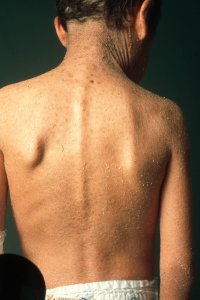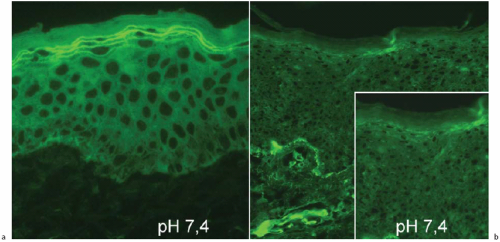Autosomal recessive congenital ichthyosis (ARCI)

Congenital ichthyoses are present at birth and as a general rule take a more severe clinical course than ichthyosis vulgaris. The most relevant and frequent type of congenital ichthyoses concerns. Autosomal recessive congenital ichthyosis (ARCI)
These types are much less frequent than ichthyosis vulgaris or RXLI. Data from Spain allow an estimate of ARCI prevalence: 1:62000 inhabitants.
ARCI is not a single disease entity, but rather a group of genetically distinct diseases. Today, ten different genes have been identified in which mutations result in ARCI. The clinical severity of these distinct genetic forms is variable.
The children are mostly born as collodion babies. In some the skin is very inflammatory while in others inflammation of the skin is mild or even absent. Also size and color of the scales can vary. Many affected present with a fine or lightbrown scaling, while other have much thicker, platelike and mostly darkbrown scaling. The scales are mostly formed by thin layers of horny cells that adhere to each other and have a lamellar aspect. Therefore in the past the term lamellar ichthyosis was often used for those having plate-like coarse and darkbrown scaling. The skin dryness and tautness can result in everting the lower eye lid, a phenomenon called ectropion. Palms and soles usually exhibit hyperlinearity or even obvious keratosis.The major body folds (flexural folds and popliteal folds) are always involved.
Most ARCI patients have difficulties to perspire and suffer from hypohidrosis. This clinical feature can be marked even in mildly affected ARCI forms and can result in an increase of the body temperature – fever – in particular in the summertime. It is important to look after ARCI infants in the hot months of summer and to provide if necessary an external cooling for example by wet dressings or application of thermal spray to the face and neck region. Children usually make at an early age the experience that exposure to heat due to sunshine does not benefit them. It is advisable to consider these aspects also when planning the yearly vacation.
Some ARCI-affected have curved finger and foot nails or nail growth can be impaired. Occasionally hair growth is affected in those having plate like scaling on the scalp in the form of localized scarring alopecia.
The most frequent type of ARCI is due to mutations in the gene TGM1 encoding for the enzyme transglutaminase 1. This type is responsible for around 32 per cent of all ARCI cases. The enzyme transglutaminase 1 is important for the assembly of the so called cornified envelope which surrounds the corneocytes and gives them stability. Moreover, transglutaminase 1 attaches the lipid envelope to the cornified envelope. In table 1 (below) the known genetic defects associated with the various ARCI types are listed.

a) normal activity with prominent Enzyme signal in the cell membranes of the granular layer
b) lacking activity in a Patient suffering from transglutaminase 1 deficiency as a cause of ARCI
For diagnostic purposes monitoring the activity of transglutaminase 1 directly in the skin no longer plays a major role and nowadays diagnosis is mostly made by a blood test (molecular sequencing).
